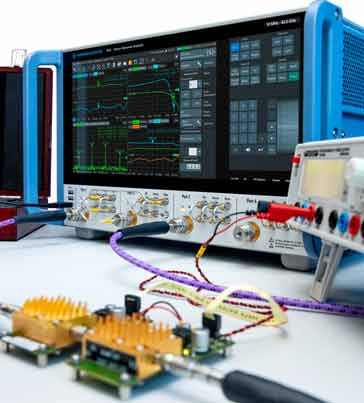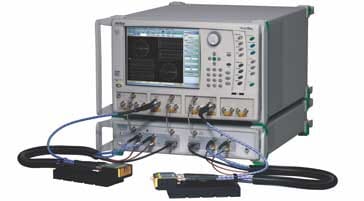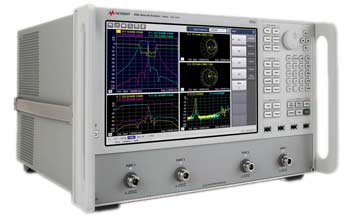Vector Network Analyzer VNA Specifications Explained
Understand what vector network analyzer, VNA specifications mean and how they reflect into the performance so the right RF network analyzer can be selected.
RF vector network analyzer includes:
What is a VNA
VNA calibration
VNA specifications
Scalar analyzer
Purchasing or selecting a vector network analyzer, VNA may not be as easy as it can be for other test instruments.
RF network analyzers can cost significant amounts of money and when buying or renting test equipment it can be a daunting task. A mistake can cost a significant amount of money.

When looking at vector network analyzers, there are some key specifications to note. Understanding vector network analyzer specifications is essential to ensure that the right selection is made.
The different vector network analyzer specifications give the keys to the performance of the test instrument - some specifications being more important than others depending upon the particular situation and applications and tests envisaged.
Key VNA network analyzer specifications
Although all the vector network analyzer, VNA specifications are important, some are more important than others dependent upon the particular situation and the tests that might need to be done, the frequencies to be used, etc.
These are some of the key parameters that need to be closely examined when selecting the right RF network analyzer for any applications
Vector network analyzers are often expensive items of test isntrumentation, and therefore a careful examination the proposed test isntrument and its specifications
- Frequency range: This is the main specification. A network analyzer’s frequency range defines the minimum and maximum frequencies it can measure. The vector network analyzer frequency range is key because it will not be possible to take measurements outside this range.
When determine the frequency range that will be required for the RF network analyzer it is worth remembering that it will be necessary to measure the network performance at not only he fundamental frequency, but also harmonics to see how the network will respond at these frequencies - this is particularly important for items like amplifiers, mixers, converters etc whee harmonic performance is a major issue. Accordingly it is normally recommended that the VNA network analyzer top frequency should be around two to five times maximum operational frequency.
It is also worth considering not only current but also future requirements. As vector network analyzers are normally expensive items of test instrumentation, they are likely to be retained for some while if bought rather than rented. However there is a cost balance, because increasing the top frequency of the VNA will have a significant impact on its cost. - Dynamic range: The VNA dynamic range is another very important specification and it defines the range of power over which the RF network analyzer will work. This can be important where there is a large variation between the maximum and minimum power levels that may be involved in a measurement. This VNA specification should be at least 6 dB better than the maximum attenuation anticipated within the device under test.
Most main stream vector network analyzers are able to offer dynamic range specifications in excess of 120dB and this is normally more than adequate for all but the most exacting requirements, but it is still necessary to check out the performance in the is respect to ensure it meets the requirements for the tests. Trace noise: Trace noise is an important RF network analyzer specification if the test instrument is to be used for applications like measuring filter ripple performance. It can be a key factor in the accuracy of some measurements.
Noise is always present to some degree and is generated within the RF network analyzer. The VNA trace noise specification details that amount of noise present on a measurement. It is typically measured in milli-dB (0.001 dB).
Number of test ports: A network analyzer can have two, four, or more test ports. Dependent upon the types of devices that will need to be measured, the required number of ports will need to be available. many devices only require two ports, for tests on devices that have more than two ports, analyzers with additional ports will be needed. Obviously the more ports on a test instrument, the greater the cost, so a balance needs to be found.
- Measurement speed: This is the time required to perform measurements across a range of frequencies. Measurement speed can be an important parameter in a number of instances. As measurements require the vector network analyzer to sweep over a range of frequencies, taking measurements of with signals entering the device under test from the ports, tests can take an appreciable amount of time - it is not just a single measurement that is made.
For one-off bench tests, the measurement time may not be too much of an issue, but where a host of measurements need to be made to fully characterise a device over a variety of scenarios, testing can take a significant amount of time. Reducing the measurement time, can in some instances have a significant impact on the overall development time.
Vector network analyzers are being increasingly used in production environments as advanced RF products are being used increasingly and some require in-depth testing to be undertaken. Here the measurement time can have a major impact on production throughput. Reducing the VNA network analyzer test time can increase throughput and therefore have a major impact on production costs.
Benchtop VNA, USB VNA or PXI VNA?: Although bench vector network analyzers are still the most widely used, other options are also available.
USB VNAs are now starting to hit the market. By using the processing of the computer for the control and display of the measurements, the USB RF analyzer itself can focus on making the RF measurements and undertaking the signal processing. Typically an FPGA will be used to undertake the signal processing as it requires a significant amount of processing to achieve this. As computers are often used in association with many test instrumentats, choosing a USB vector network analyzers can often make a lot of sense.

RF vector network analyzer When considering the USB sector network analyzer option, ensure that the computer operating system you use is supported. Most will support the use of Windows. Only some are be able to support the use of Linux or Apple iOS.
In addition to options like USB VNAs, rack systems like PXI also offer an attractive solution for many different situations, especially where a rack of equipment is to be used for control and measurement. Using PXI requires the use of a PXI rack, but enables a good number of instruments to be run within his environment, linked together physically to save space and electronically to improve performance and save on costs.
- Interfaces: Seldom these days are test instruments used in isolation on a bench. Often they are connected to computers or automated test systems where the RF network analyzer may be controlled by an external computer to automate the testing, or the results may be downloaded onto a computer for further analysis. Whatever the requirements, the available interfaces should be considered.
Interfaces including GPIB, Firewire, USB, Ethernet, etc can all be used. It is worth checking that the interfaces available match those that are required for any existing system to which this might be added.

General considerations
When buying an RF vector network analyzer, there are a number of points to consider. Obviously the basic RF specifications are important, but other aspects also play a part in the choice of analyzer.
- High End vs Low End: There are very many small, low end vector network analyzers appearing on the market. Typically these are driven from a computer and for the price they offer excellent value for money. They won't offer the performance and specifications of the high end devices, whether boxed bench vector network analyzers or even the high end USB VNAs, but for many amateur or even some professional applications, these VNAs can offer a sufficiently high level of performance. However where accuracy, performance and top specifications are needed, the high end devices are the only option.
- Size: The traditional high end vector network analyzers tend to be large and cumbersome. This is fine for many laboratory applications, but if VNA measurements are needed on the go, smaller test instruments are needed. It is always worth considering the size as part of the buying process.
- Power: Another vector network analyzer specification that can be important is the power required. Whilst it will not be an issue for mains powered analyzers, for those powered via a USB port or other means it could be. It is certainly worth checking that the power can be supplied. Remember that not all USB port always have the same current capability, etc, t is always worth checking.
Understand what the key measurements are for any RF network analyzer is key to being able to focus on the important specifications. Understanding what these vector network analyzer specifications mean, enables an informed choice to be made about the right test instrument for any given situation
Having a key understanding of the specifications not only enables the right RF network analyzer to be bought, but it also provides a better understanding of the limitations of any VNA that may be used and thereby enabling better results to be achieved.
 Written by Ian Poole .
Written by Ian Poole .
Experienced electronics engineer and author.
More Test Topics:
Data network analyzer
Digital Multimeter
Frequency counter
Oscilloscope
Signal generators
Spectrum analyzer
LCR meter
Dip meter, GDO
Logic analyzer
RF power meter
RF signal generator
Logic probe
PAT testing & testers
Time domain reflectometer
Vector network analyzer
PXI
GPIB
Boundary scan / JTAG
Data acquisition
Return to Test menu . . .



